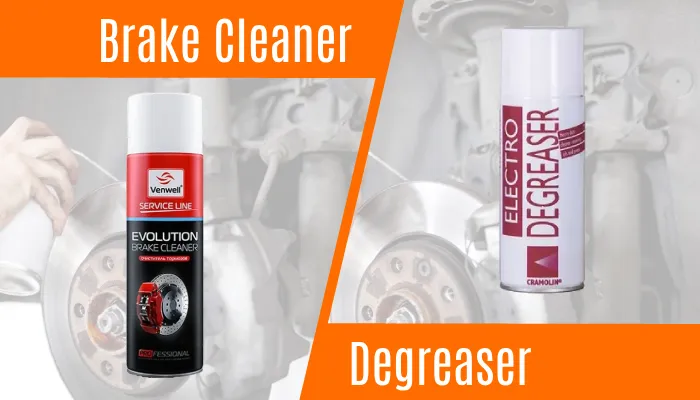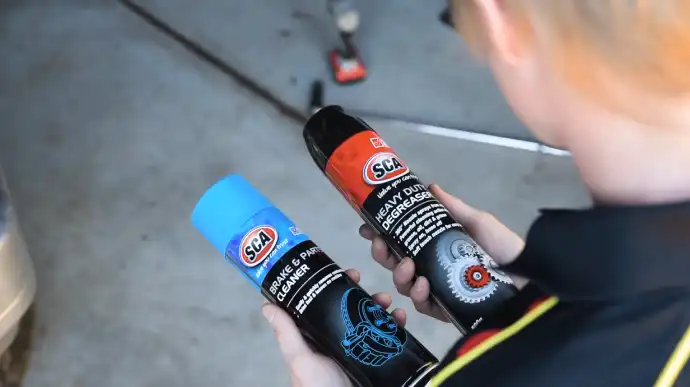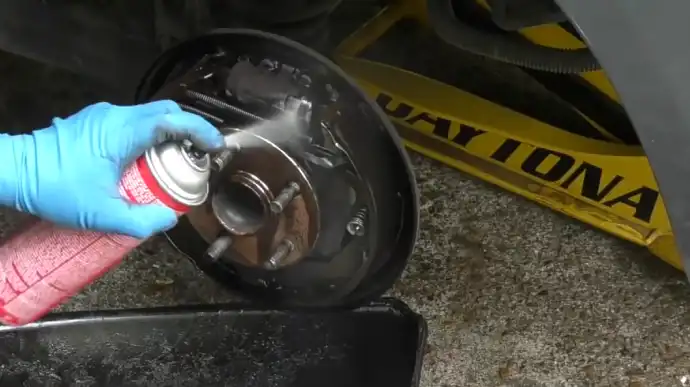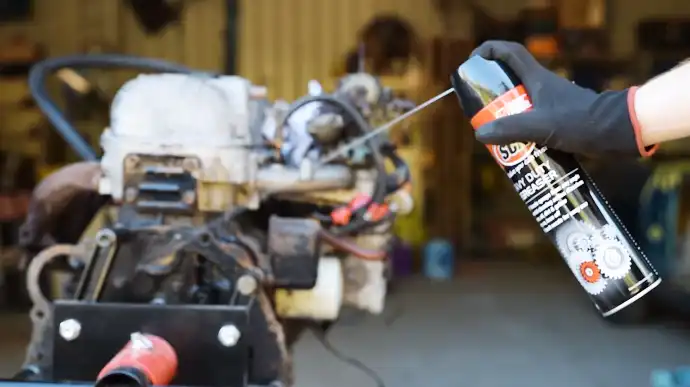Physical Address
304 North Cardinal St.
Dorchester Center, MA 02124
Physical Address
304 North Cardinal St.
Dorchester Center, MA 02124

Your choice of brake cleaner or vehicle degreaser can have a significant impact on the effectiveness of cleaning and the overall health of your vehicle. These two cleaning agents serve distinct purposes and possess unique characteristics that make them suitable for specific tasks.
Brake cleaner is specifically designed to remove brake fluid, grease, oil, and contaminants from braking systems and electrical components. At the same time, a vehicle degreaser is used for cleaning engine parts and engine bays.
As a solvent, brake cleaner primarily relies on isopropyl alcohol as a solvent. Unlike vehicle degreasers, which are typically petroleum-based and leave an oily residue, it evaporates quickly.
Here, we’ll explore the nuances of these products, including their intended use, composition, impact on materials, residue left behind, environmental considerations, versatility, safety, and cost. Additionally, we’ll address common questions about their use in engine cleaning and maintenance.

Regarding the differences between brake cleaner and degreaser for vehicles, there are several key points to consider. And while both have the same end goal of cleaning grease and oil from metal parts, each does it in a slightly different way.
To understand the purpose and intended use of brake cleaners and degreasers for your vehicle, you need to know the distinct functions they serve.
Brake cleaner is specifically formulated to clean braking systems and electrical components. Its primary purpose is to remove contaminants such as brake fluid, grease, oil, and grime that can compromise the performance of the brakes.
The brake cleaner is designed to work without disassembling the braking system, making it an efficient and convenient solution.
On the other hand, vehicle degreaser is primarily used to clean engine parts and engine bays. It’s specifically formulated to remove oils, lubricants, adhesives, and contaminants that accumulate in the engine compartment.
However, it’s important to note that vehicle degreaser shouldn’t be used on a car’s exterior, as it can strip off paint.
You can differentiate brake cleaner from degreaser for your vehicle by understanding the cleaning agents and the composition they contain.
For removing brake dust, oil, and other contaminants, brake cleaners use isopropyl alcohol, a highly effective solvent. It evaporates quickly and leaves no residue, making it ideal for brake maintenance.
Conversely, vehicle degreasers are typically petroleum-based, which allows them to break down heavy grease and grime on engine components. However, this composition can leave an oily residue behind, especially on surfaces other than engine parts.
Brake cleaner, being less harsh, is generally safe to use on delicate brake components. It evaporates quickly without causing damage to plastics, rubber parts, or paint as long as it’s used with caution.
In contrast, vehicle degreasers, especially petroleum-based ones, have a stronger chemical composition that can potentially harm materials such as painted objects, plastics, aluminum, and chrome. This highlights the need to exercise caution when using degreasers and to follow the instructions provided.
When using brake cleaner or degreaser on your vehicle, it’s important to consider the residue left behind by each cleaning agent.
Brake cleaner is renowned for leaving no residue after application. Its rapid evaporation ensures that no oily or chemical film remains on the surfaces you clean. This is especially beneficial when working on sensitive components like brake pads and rotors, where any residue can compromise their performance.
Meanwhile, vehicle degreasers, particularly those with a petroleum base, may leave an oily residue. While this residue may not affect the functionality of certain components, it can negatively impact the appearance of your vehicle.
Brake cleaner, with its isopropyl alcohol-based formula, is considered less environmentally harmful. Isopropyl alcohol evaporates quickly, reducing the amount of chemical residue left behind. This makes brake cleaner a preferred choice in regions that prioritize environmental concerns.
On the other hand, vehicle degreasers, particularly those that are petroleum-based, can have a more significant environmental impact. These degreasers may contain harmful chemicals that can contaminate soil and water sources if improperly disposed of.
While brake cleaner is primarily used for brake systems and electrical components, its quick-drying properties make it suitable for other tasks as well. It can locate leaks by quickly evaporating and leaving a clean surface for inspection.
Additionally, brake cleaner is effective for cleaning car parts such as carburetors, throttle bodies, and intake valves.
Conversely, a vehicle degreaser is specifically formulated for engine cleaning and lacks the versatility of a brake cleaner. Its purpose is to remove grease, oil, and grime buildup from engine components, providing optimal performance and prolonging the engine’s life.

To ensure safety in welding environments, it’s important to consider the differences between using brake cleaners and degreasers for vehicles.
Regarding brake cleaner, a notable concern arises due to its chlorine content. During welding, the high temperatures can cause the residual chlorine in chlorinated brake cleaner to convert into phosgene gas. This gas is highly toxic and poses a significant risk to the health and well-being of nearby individuals.
On the other hand, vehicle degreaser, while not specifically designed for welding environments, doesn’t carry the same risk. While it may not offer the same effectiveness in removing contaminants, its use in welding environments is a safer choice as it eliminates the potential danger of phosgene gas formation.
Brake cleaner requires extra caution due to its flammability and potential hazards. It’s crucial to avoid contact with the skin and eyes, as well as heat and ignition sources. Adequate ventilation is essential to prevent the buildup of vapors that can be harmful.
On the other hand, vehicle degreasers, while still requiring precautions, may not have the same level of flammability risk as some brake cleaner formulations. You should still follow the instructions on the product label for both brake cleaner and degreaser to prevent accidents.
Brake cleaner is a specialized solution specifically formulated for brake systems, which justifies its higher price. Its unique composition and quick evaporation properties make it efficient and effective for brake cleaning tasks.
Alternatively, vehicle degreaser offers cost savings but may leave behind an oily residue and have a harsher effect on materials. Despite these trade-offs, the affordability of vehicle degreasers makes them a popular choice for general vehicle cleaning and degreasing purposes.
Alternatively, some vehicle degreasers are water-based, which are gentler on materials and more environmentally friendly. However, they tend to be costlier than petroleum-based degreasers.
Mechanics rely on brake cleaners for their versatile cleaning properties and ability to effectively remove contaminants from various vehicle components.
Brake cleaner contains strong solvents that dissolve grease, oil, dirt, and brake dust, making it an essential tool in automotive maintenance and repair.
When sprayed onto brake calipers, brake cleaner quickly cuts through built-up grime, allowing for smooth and efficient operation. It’s also commonly used to clean brake pads, brake drums, and brake rotors, ensuring optimal braking performance.
Additionally, mechanics use brake cleaner to degrease engine parts, such as throttle bodies, carburetors, and intake manifolds. Its fast-evaporating formula leaves no residue behind, making it safe to use on electrical connections and sensors.
Brake cleaner, when used improperly or excessively, can potentially harm the engine by causing damage to its sensitive components. The main concern is that brake cleaner is a powerful solvent that can dissolve grease, oil, and other contaminants. However, it can also strip away the protective lubricants on engine parts, increasing friction and wear.
Additionally, brake cleaner is highly flammable, and if it comes into contact with hot engine components, it can ignite and cause a fire. To minimize the risk of damage, it’s important to use brake cleaner sparingly and only on specific areas that require cleaning.
You can also use brake cleaner as a degreaser for your vehicle. Brake cleaner is a versatile product that can effectively dissolve and remove grease from various surfaces. Its ability to dry without residue makes it an ideal choice for degreasing.
When using brake cleaner as a degreaser, simply spray it onto the greasy area and allow it to penetrate and dissolve the grease. You may need to scrub the surface lightly with a brush or cloth to help remove stubborn grease. Once the grease is dissolved, wipe away any excess cleaner and residue.

Using a suitable degreaser in moderation won’t cause damage to your disc brakes. However, it’s important to be cautious when applying degreaser near the brake calipers, brake pads, and rotors, as contamination in these areas can lead to squeaky brakes.
When using a degreaser, avoid spraying it directly onto the brake components. Instead, apply the degreaser onto a clean cloth and carefully wipe away any grease or dirt from the surrounding areas.
It’s also recommended to cover the brake components with a plastic bag or protective shield to prevent any accidental contact with the degreaser.
In automotive maintenance, the selection between brake cleaner and vehicle degreaser is far from trivial. Understanding the specific purposes, cleaning agents, and potential consequences of using one over the other is crucial for maintaining vehicle safety and performance.
Brake cleaner, with its quick evaporation, minimal residue, and focus on brake systems, is the go-to choice for ensuring brake performance and safety. On the other hand, a vehicle degreaser, with its capacity to handle heavy grease and grime in engine components, is a cost-effective solution for engine maintenance.
Mechanics use brake cleaners specifically for cleaning brake components, while degreasers are more versatile and can be used on various vehicle parts.
Brake cleaner isn’t recommended for use on engines as it can be harmful, but degreasers can effectively remove grease and grime.
So, whether you’re a DIY car enthusiast or a seasoned mechanic, choosing the right brake cleaner and vehicle degreaser can make all the difference.